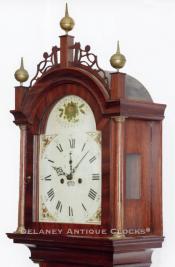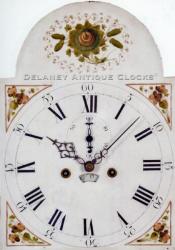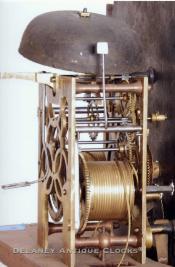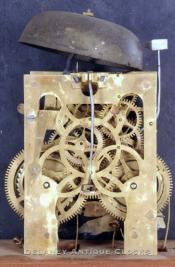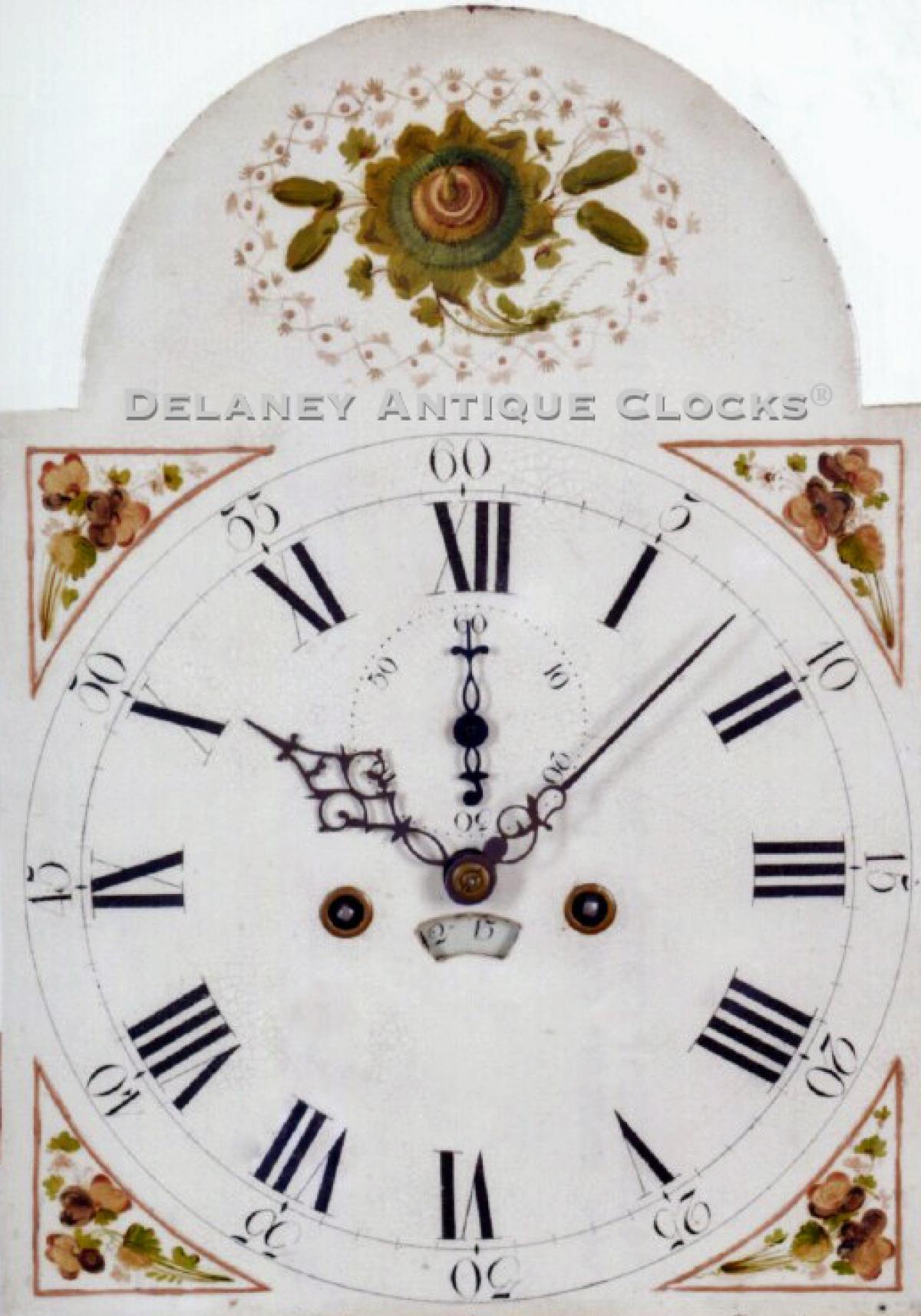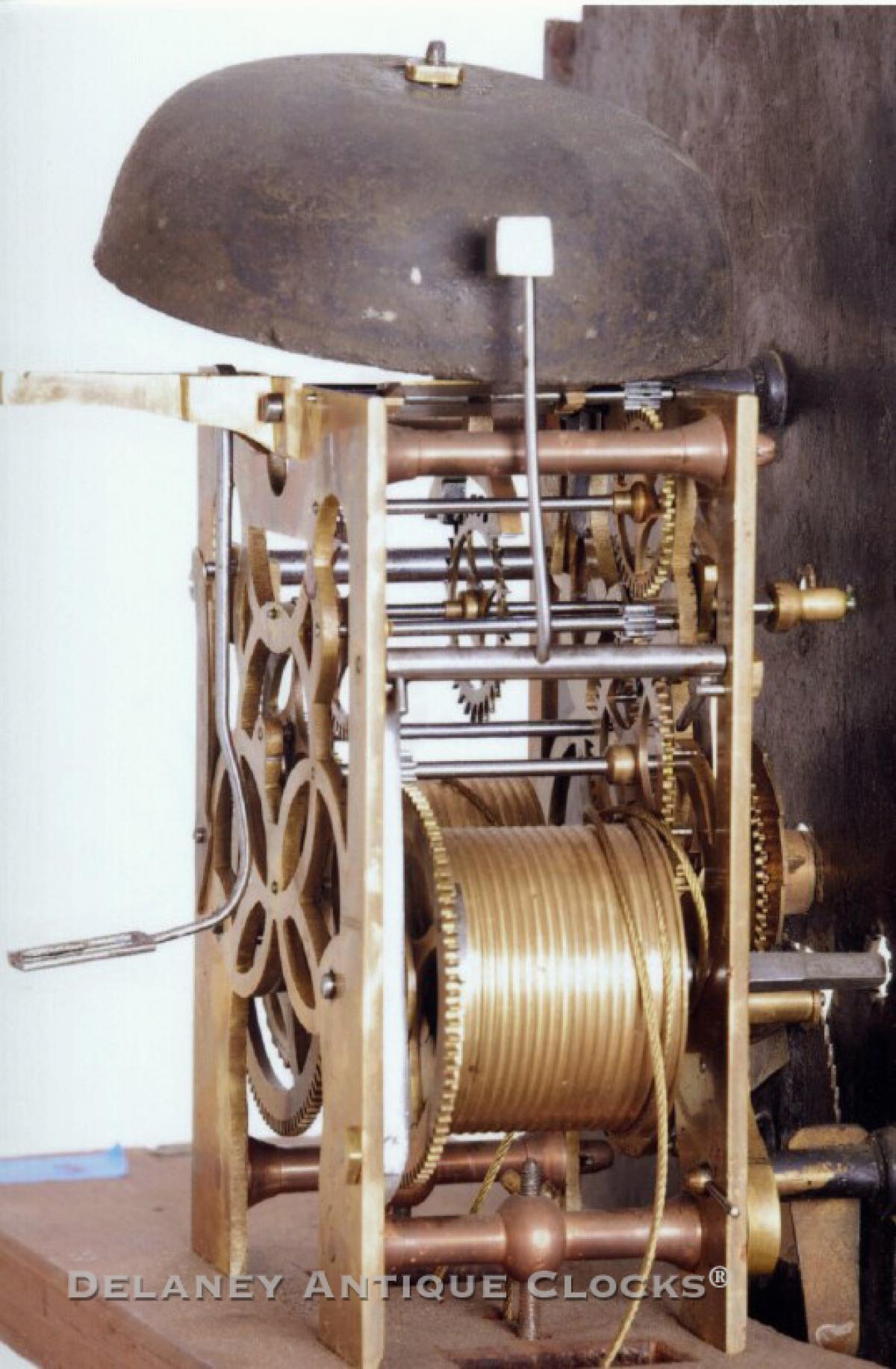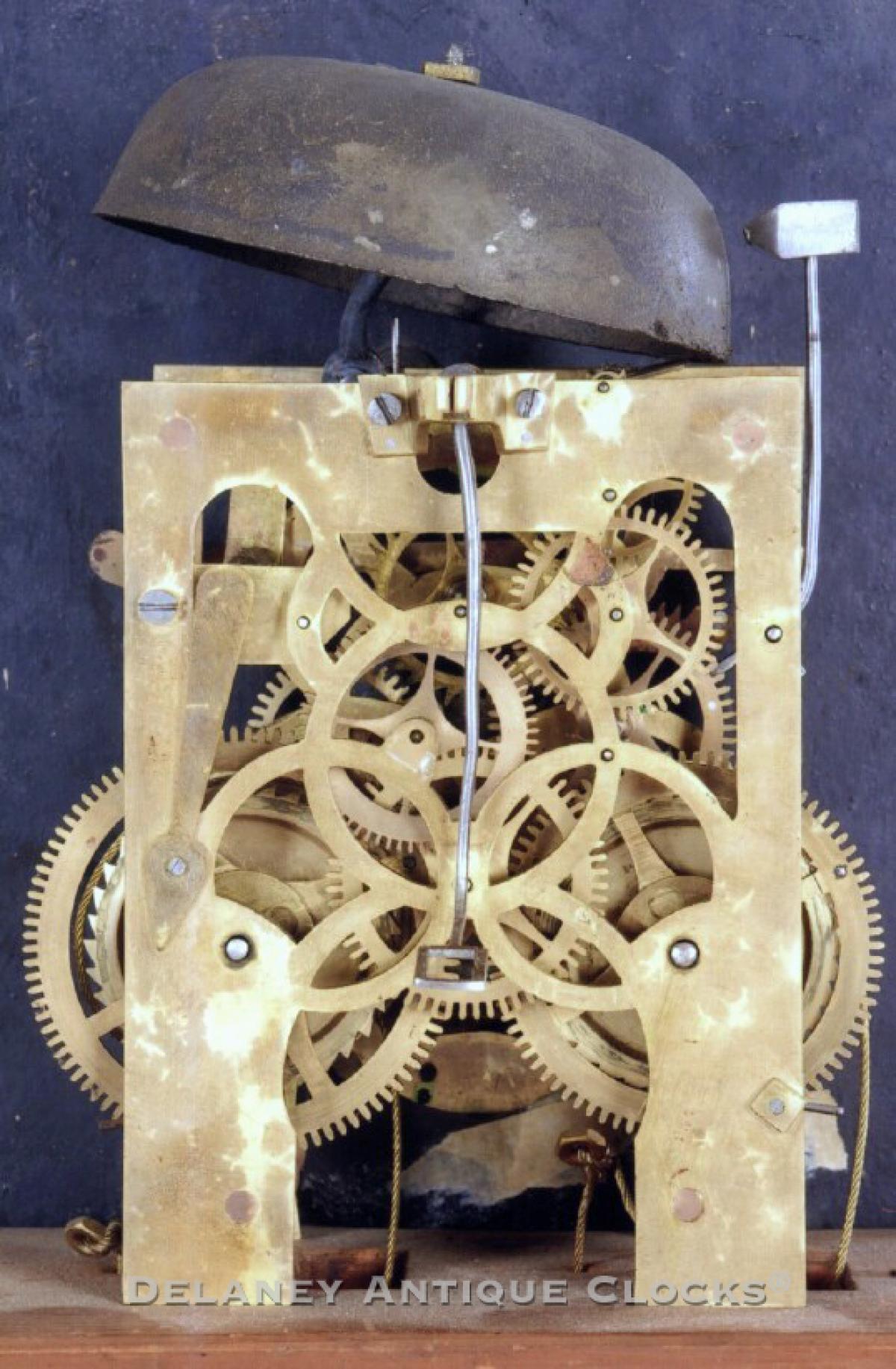A Fine Federal Tall Case Clock. The works are attributed to the Hanover, Massachusetts, clockmaker John Bailey II, and the cabinetmaker Abiel White of Weymouth. Circa 1815-20. 217073.
This handsome diminutive sized clock was most likely produced by the prolific Quaker clockmaker John Bailey II [1751-1823] of Hanover, Massachusetts. Since the clockmaker and not the cabinetmaker usually gets the credit for the clock, this attribution is based on the construction of the clockworks.
John Bailey was the most prolific member of a renowned family of skilled and innovative clockmakers. The Bailey family is credited with training the majority of clockmakers from the Southeastern Massachusetts region. The construction of this brass movement is somewhat distinctive in that it features heavily skeletonized brass plates. This is the process of removing the excess brass from the plates to economize the use of this expensive material. The Baileys and a number of their apprentices are known to have participated in this practice. The plates used in the construction of this set of clockworks are wonderfully scrolled out, leaving behind a free-flowing decorative pattern of multiple circles. The brass plates frame the gearing. The gears are supported on hardened steel shafts. Two heavyweights power the mechanism, and it is designed to run for eight days on a full wind. One weight is for the time side of the mechanism, the second weight drives the hour-strike train. The strike is actuated by a rack and snail setup, which is mounted to the front plate of the works. When released, a hammer hits a cast iron bell with the appropriate blows. This bell is mounted above the movement on a bell stand. The pendulum hangs from the back of the movement on a post. The lead bob is capped with brass on its' forward-facing surface. The movement is supported on a wooden "saddle board," and it is original to the case.
The high-quality construction and superb wood selections, in this case, suggest a sophisticated buyer. When ordering the case, he requested some of the best workmanship of the day. This exceptional example is fantastically proportioned. The formal case is an interpretation of the "Roxbury" style and was made in Southeastern Massachusetts. The hood is fitted with a delicately scrolling fretwork set between three chimneys, each supporting its' own period brass finial. The finials have a reeded ball below a spire. This fretwork rests on an arched molding. This is embellished with a complicated line inlay pattern set into the outermost detail of the molding. The molded arch is positioned above a glazed tombstone, and mahogany cross-banded veneered dial door. The door is flanked by a pair of brass stop-fluted columns that terminate in brass capitals and bases. The sides of the clock hood have tombstone-form glazed windows. Through these one can see the clock's mechanism.
The dial door opens to a painted dial of Boston manufacture, which remains in pristine condition with even crazing. During this period, Boston was a center for dial manufacturing. Boston dials are known for their high quality and regional style and were employed by clockmakers throughout the United States. This dial features several floral decorations that are located in the lunette and also in the spandrel areas. The clock face has a ring of Roman numerals to demark the hours and an outer ring of Arabic numerals to demark five-minute increments. The center arbor is fitted with cut steel hands. The dial is also fitted with a second bit above the center arbor and a calendar opening below it.
The hood transitions into the waist section with a flared throat molding above a hinged pendulum door. The door is flanked with brass stop-fluted quarter columns that terminate in brass quarter capitals and bases. The hinged pendulum door is fitted with an applied molding along its perimeter. The panel features cross banded border, a line inlay, and a vibrantly figured mahogany veneer. The cabinetmaker used dramatically contrasting inlay patterns in both this door and the lower panel. This contrast is emphasized by the deep surface color to great effect. The door is fitted with a lock and brass keyhole surround.
The narrow waist section transitions to the base with flared molding. The rectangular base panel has a cross-banded mahogany border around a rich crotch-grained panel of mahogany veneer. Additional light line inlays frame these elements. The base is elevated on four nicely formed feet with spur returns. This distinctive pattern is associated with the cabinetmaker.
The overall height is 88.5 inches or 7 feet 4.5 tall to the top of the center finial. At the upper hood molding, it is 19.75 inches wide and 8.75 inches deep.
Inventory number 217073.
John Bailey II was born on May 6, 1751, in Hanover, Massachusetts, the son of Colonel John Bailey, a shipbuilder, and Ruth Randall Bailey. He died there 72 years later, in 1823. It is believed he learned clockmaking at a young age and may have been self-taught. John t on January 23, rained numerous apprentices, including his younger brothers Calvin and Lebbeus, his son John III, Joseph Gooding, Ezra Kelley, and Joshua Wilder from Hingham. Many of his apprentices moved to other towns in southeastern Massachusetts and became well-known in their communities. John was the most prolific clockmaker among the six Baileys involved in the craft.
John's clocks can be categorized into two main types. The first is a home-developed style, which often features sheet brass dials that are engraved and treated with a silver wash. Several examples we know of have movements constructed from wood, while others are made of brass with fully skeletonized plates. Some later models incorporate wooden winding drums. Notably, he produced both types of strike trains; we have seen signed examples that feature a count wheel setup and the more common rack and snail configuration. Very few clockmakers used both setups. The cases are usually made from indigenous woods like maple and cherry, showcasing pleasing country proportions without the sophistication of the Roxbury School. The 'Roxbury/Boston influence' refers to the design and craftsmanship styles that were popular in these areas at the time. Around 1790, this influence likely played a significant role in John's production. The movements in these examples more commonly feature fully plated mechanisms. Additionally, the cases resemble those produced by the Willard School to the north, which often showcase mahogany cases decorated with inlays. This second generation of output appears much more formal.
Over the years, our collection has included a diverse range of clocks crafted by John Bailey II. From tall-case clocks to dwarf clocks, banjo or wall timepieces, and the unique Massachusetts shelf clock form, his versatility as a clockmaker is truly intriguing.



